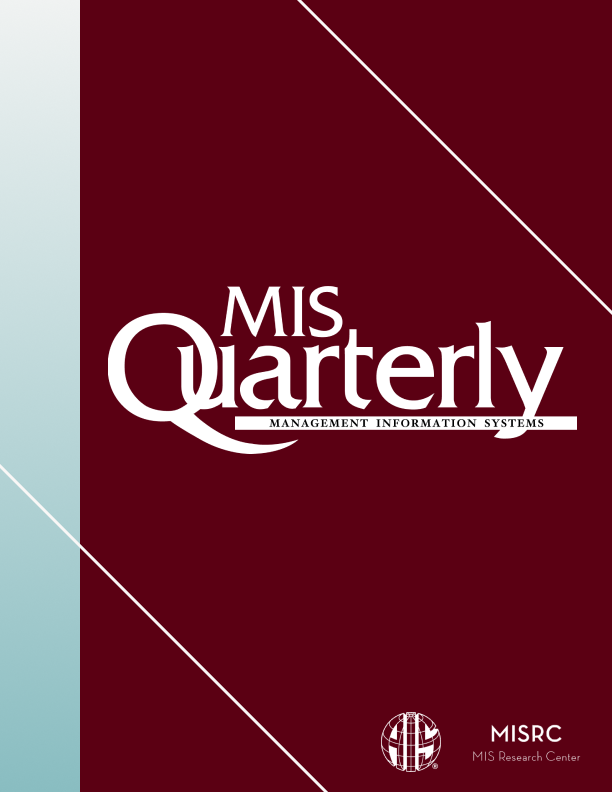平衡承受力与制约力:为组织知识工作设计企业社交媒体
IF 6
2区 管理学
Q1 COMPUTER SCIENCE, INFORMATION SYSTEMS
引用次数: 0
摘要
#html-body [data-pb-style=MMV4CPM]{justify-content:flex-start;display:flex;flex-direction:column;background-position:left top;background-size:cover;background-repeat:no-repeat;background-attachment:scroll} 企业社交媒体(ESM)正在改变知识工作者交互和共享信息的方式;然而,关于ESM是否是一个适当的知识管理系统的争论一直存在。ESM为组织知识工作提供了丰富的功能,如改善组织记忆,但也因数字干扰而限制了知识工作的绩效。本研究在扩展和补充现有研究成果的基础上,提出了以下研究问题:组织如何设计无害环境管理以实现其知识工作优势?本研究使用了一个基于计算代理的模型,该模型结合了无害环境管理的设计特点、工作人员的态度以及由此产生的无害环境管理使用能力和限制,展示了无害环境管理的使用结果如何取决于无害环境管理的设计和用户对无害环境管理的态度。具体来说,如果员工的透明度偏好较低,不需要发布太多信息就能访问 ESM,那么 ESM 互动性的负面影响就会减轻。这项研究进一步揭示了非对称参与的机制,这种机制导致低透明度配置更能抵御ESM互动性带来的负面影响。非对称参与--在不经常互动的情况下学习发布的内容--使组织记忆得以逐步形成,同时通过最大限度地减少中断来维持广泛的用户基础。这些结果最终为ESM的使用和知识工作成果提供了一个多层次模型,加强了对以前研究过的机制(如交流可见性)的理论理解,并为设计ESM的组织提供了启示。本文章由计算机程序翻译,如有差异,请以英文原文为准。
Balancing Affordances and Constraints: Designing Enterprise Social Media for Organizational Knowledge Work
Enterprise social media (ESM) is changing how knowledge workers interact and share information; however, a debate persists as to whether ESM is an adequate knowledge management system. ESM provides a rich set of affordances for organizational knowledge work, such as improved organizational memory, but also constrains knowledge work performance because of digital interruptions. Extending and complementing existing scholarship, this study asks the following research question: How can organizations design ESM to realize its knowledge work benefits? Using a computational agent-based model that incorporates the design features of ESM, workers’ attitudes, and resulting ESM-use affordances and constraints, this study shows how ESM-use outcomes are contingent both on the design of and users’ attitudes toward ESM. Specifically, the negative effects of ESM interactivity are mitigated when employees have a low transparency preference and access ESM without posting as much. The study further unpacks asymmetric engagement as the mechanism that leads low transparency configurations to be more resilient to the negative effects of interruptions driven by ESM interactivity. Asymmetric engagement—learning from posted content without interacting often—enables the gradual creation of organizational memory while maintaining a broad user base by minimizing interruptions. These results ultimately contribute a multilevel model of ESM use and knowledge work outcomes, enhancing the theoretical understanding of previously studied mechanisms such as communication visibility and providing implications for organizations designing ESM.
求助全文
通过发布文献求助,成功后即可免费获取论文全文。
去求助
来源期刊

Mis Quarterly
工程技术-计算机:信息系统
CiteScore
13.30
自引率
4.10%
发文量
36
审稿时长
6-12 weeks
期刊介绍:
Journal Name: MIS Quarterly
Editorial Objective:
The editorial objective of MIS Quarterly is focused on:
Enhancing and communicating knowledge related to:
Development of IT-based services
Management of IT resources
Use, impact, and economics of IT with managerial, organizational, and societal implications
Addressing professional issues affecting the Information Systems (IS) field as a whole
Key Focus Areas:
Development of IT-based services
Management of IT resources
Use, impact, and economics of IT with managerial, organizational, and societal implications
Professional issues affecting the IS field as a whole
 求助内容:
求助内容: 应助结果提醒方式:
应助结果提醒方式:


